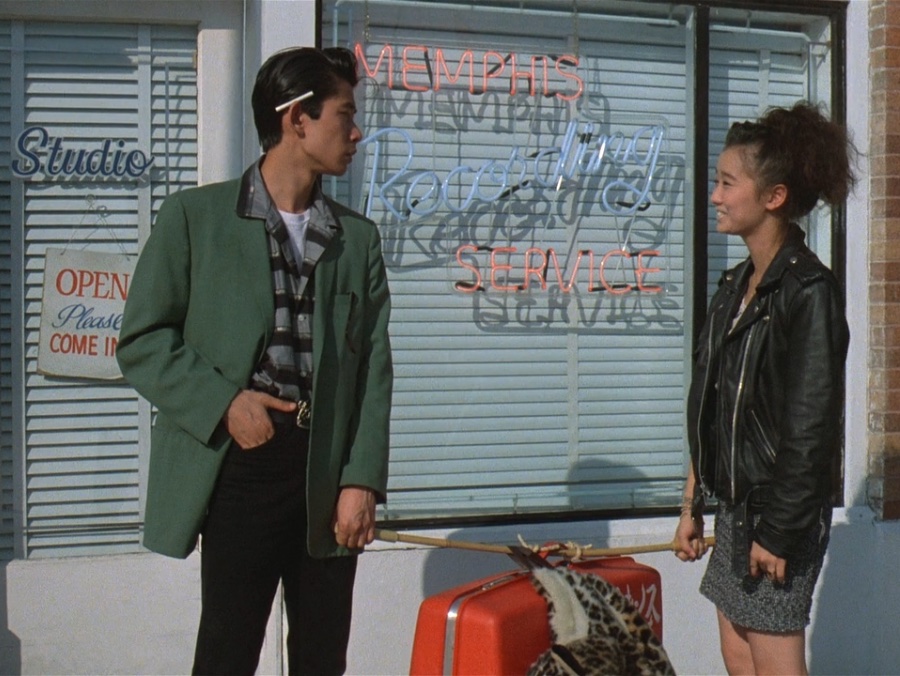
A rock ’n roll-obsessed Japanese couple pays a visit to Graceland, the home of Elvis. An inept gang of thugs hide out after a liquor store robbery. A frazzled Italian widow has a ghostly encounter with the King himself. All their stories collide in one sleazy downtown motel in Memphis, Tennessee.
EN
“Mystery Train might be the apogee of Jarmusch's interest in the past-its-prime corners of America, capping off a quasi-trilogy that began with Stranger Than Paradise (1984) and Down By Law. Without a doubt one of the greatest films about Memphis ever made, Mystery Train proudly pays its dues to the musical legends and ghosts that call the birthplace of rock 'n' roll home. Japanese tourists introduce the city in the film's first vignette, having traveled from Yokohama to see Sun Studios and Graceland in their pursuit of the King. The second section, ‘A Ghost,’ finds another stranger to Memphis (Nicoletta Braschi) fleeing an ominous man in a diner only to end up splitting the cost of a hotel room with a down-on-her-luck chatterbox. The third section, ‘Lost in Space,’ is by far the best display of Jarmusch's dry sense of humor, a comedy of errors featuring Joe Strummer (yes, of The Clash), Steve Buscemi, and Rick Aviles. While the vignettes are ostensibly separate narratives, the Hotel Arcade (run by a desk clerk played by Screamin' Jay Hawkins), a passing train, Tom Waits' voice, Elvis' eerie ballad ‘Blue Moon,’ and a gunshot link them all.
Cine-tourists who visit the corner of South Main Street and G.E. Patterson Boulevard today will find it as unrecognizable from its seedy starring roll in Jarmusch's film. Even the Hotel Arcade has long since been torn down, its location indicated only by a plaque memorializing Mystery Train as the birth of the ‘modern wave of Memphis moviemaking.’ But while Memphis might be a little less dilapidated than it used to be, the film remains a beautiful tribute – if not to one of the less-than-glamorous American cities, then to the puzzling and serendipitous ways we all fit together within them.”
Jeva Lange1
“It's now obvious that calling his comedies shaggy-dog stories isn’t good enough. They aren’t really stories at all. Each is an amalgam of attitudes, images and music, especially music (blues, jazz, rock), which evoke something most cheering and comic about the human condition, even in extremis. Watching Mystery Train for the second time, I was especially struck by what a fine screenwriter Mr. Jarmusch has become. The dialogue sounds as if it had been gathered by means of microphones hidden in diners, buses, waiting rooms, restrooms, motels and park benches. Sometimes hilariously banal, with never a word wasted.”
Vincent Canby2
“Long before the mainstreaming of allyship, faux- and genuine, into cultural discourse, Jarmusch set himself apart from other like-minded white directors by incorporating Black art and artists into his work. His cross-cultural ethos organically demanded he not only reject the marginalization of non-white cultures, but also assert that ‘white culture’ derives from appropriation. (It’s impossible to be a pronounced fan of rock ‘n’ roll without grappling with these issues.) From Mystery Train onward, Black characters move through Jarmusch’s films without being fitted for an ill-fitting pedestal, or the aid of a patronizing spotlight. […] bell hooks once cited the scene in Mystery Train when Jun and Mitsuko are delighted to hear a Black man thank them in Japanese as one that ‘challenges our perceptions of blackness by engaging in a process of defamiliarization.’ (‘Way before Tarantino was dabbling in ‘cool’ images of blackness,’ she continues, ‘Jarmusch had shown in Down by Law and other work that it was possible for a white-guy filmmaker to do progressive work around race and representation.’) A testament to the powers of moving outside of your experience, Jarmusch exhibits an ineffable comfort in his films with cultures and philosophies far from his own.”
Vikram Murthi3
“Mystery Train premiered at Cannes 1989, was a great success, and confirmed the promise Jarmusch showed when Stranger than Paradise premiered there in 1984. His influence in the1980s resurgence of indie filmmaking is incalculable. He differs from some indies, however, in the formal calculation that goes into his composition and editing. Jarmusch is in no hurry to get anywhere. He chews before swallowing. He will rest on a shot to allow it to reveal itself; shots aren’t the impatient hurrying along of a story. Notice how some of his traveling shots in Mystery Train seem to dictate the movements of characters, rather than following them. See how he isolates a portion of an interior rather than ‘establishing’ a whole location. Notice the unobtrusive manipulation of time when the drunks are riding around in a pickup.”
Roger Ebert4
- 1Jeva Lange, “Mystery Train,” Screen Slate, 7 October 2016.
- 2Vincent Canby, “A Blissful 'Mystery Train' From Jim Jarmusch,” The New York Times, 29 September 1989.
- 3Vikram Murthi, “Notebook Primer: Jim Jarmusch, Permanent Outsider,” MUBI Notebook, 10 April 2023.
- 4Roger Ebert, “And the ghost of Elvis hovers over all,” Rogerebert.com, 21 July 2010.

